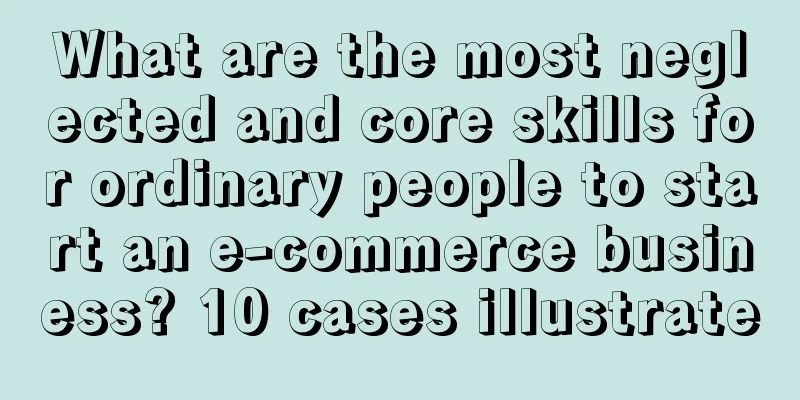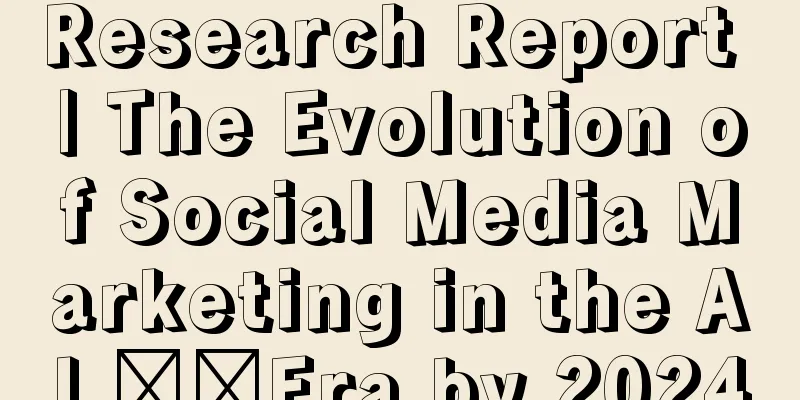Industry research methodology that can be mastered in 1 hour

In the past eight years, I have been working in product operations and industry operations in Internet companies. Among them, there is a basic but indispensable ability - industry analysis, which has been with me as I grew up. Today, I will try to systematize this ability and hope to provide some reference for those who are reading this article. Following this logic, whether you are preparing for an interview or want to quickly improve your basic industry operation skills, it will be of great help, and we strive to help you master the methodology of researching an industry in 1 hour as soon as possible. 01Three common problems in industry research:
My specific solutions to these three common problems are: 1) Ask the question first , think about what you want to know specifically, and then summarize and conclude the question. For example, I want to learn about the electric vehicle industry and why so many entrepreneurs are building cars. Besides their different power sources, what is the impact of electric and gasoline vehicles on society, consumers, and businesses? When will electric vehicles replace gasoline vehicles? Are electric vehicles purely green? First generate questions, then categorize them. Here I offer two ideas. One is to classify by roles or production flow elements , such as upstream raw materials, factory production, offline channels, consumers, etc.; the other is to classify according to the traditional SWOT model, including industry strengths, weaknesses, industry opportunities, and industry threats, such as: 2) Ask more questions, generate questions from them, and then summarize them . For example, what is the difference between the average daily cost of electric cars and gasoline cars, and why is there such a difference? What are the main driving factors for consumers to buy electric cars now, and why? Are there differences between first- and second-tier consumers and third- and fourth-tier consumers? Why? 3) Preliminary search and in-depth search , using the search engines we know, Zhihu, industry reports, and some professional podcasts to simply collect and respond to the previous inductive questions, and then search again for the keywords and key conclusions left by the preliminary records to question the logic. For example, we have shown that electric cars consume less energy than gasoline cars on a daily basis. So where are they less energy? Why are they less energy in these areas? Are there greater differences between China and other countries? You can do this until you can roughly make up the difference in cost. 4) Organize and summarize. In fact, organizing and summarizing is quite simple. You can make a summary according to the classification of the previous two types of problems. Other ways: Find a few industry experts to have in-depth chats, which is more efficient; secondly, read the books and the book lists behind the books, then pick out 3-5 books to read, and then summarize them into the above content, and that’s basically it. 02The above are very basic operations and questions. I will raise three more basic questions . You can use the content summarized above to try to answer them. Sometimes asking questions also reflects the level of your personal thinking. 1) Regarding commodities as production factors , which companies are behind this category, what is the market structure, what is the industry concentration, what is the upstream supply chain like, are there any subcategories, and are there any opportunities in the subcategories? 2) Regarding consumers , who’s problem does this product solve essentially? What are the consumer portraits and classification stratifications? What is the basis for consumers’ decision-making? 3) Regarding channels , how are products sold, what is the positioning of each channel, what are the scenarios in which transactions take place, what is the proportion of online and offline products, and what are the differences between brands? 03Here are three more intermediate questions : 1) What is the flow of funds in the entire chain? What is the voice of each role? What changes and trends will there be over time? What is the general rule of cost differences? 2) Off-market information. The PEST model can be fully embedded here and everyone can copy it. 3) What drives the development of the industry, what is the core driving force, which players have experienced which setbacks, what milestone events have occurred; what are the stages of industry development, etc. 04The last three ultimate questions: 1) What is the business model? How do funds and information flow, and how do they ultimately achieve reproduction and scale growth? What is the reason for the success of this model, and does it have the law of sustainable development? 2) What are the competitive barriers of the leading companies; what are their core competitiveness, do other companies still have opportunities, and what is the second curve of the leading companies? 3) What is the final outcome of this business field? How much is needed to reach it now? What are the conditions for reaching it? What is the impact on the entire ecosystem? What is the evolution after the final outcome is reached? Well, the above are the main core issues involved in understanding an industry. I hope it will be helpful to you. I also hope that you will not be too obsessed with the so-called methodology and data. Many times you still have to look at the business itself. The rules that apply to other industries or countries may not necessarily apply to your current industry. Author: Flower Planter |
<<: There is a kind of growth called user full-link integrated marketing
Recommend
Are women's bags selling well on Shopee Taiwan? What are the best things to sell on the Taiwan site?
Shopee Taiwan is a popular site on Shopee and is t...
Studying the North American e-commerce industry has triggered a series of deep thoughts for me
An interesting phenomenon was discovered in the st...
Who is driving the popularity of Zibo barbecue?
Zibo barbecue has become a new top food in the foo...
How long does it take to apply for Amazon UK VAT? How to apply?
Amazon has set up sites in many regions, such as t...
SHOPEE cross-border payment can be received in advance
In order to speed up your capital turnover and sho...
How to set up Shopee store ads? Tips
This article will show you some tips on how to set...
What does foreign trade ERP mean? What software are there?
There are many people doing e-commerce now. E-comm...
How can tea brands expand in scale? Share the successful experience of Bawang Chaji in starting a business
Tea brands have a large share in the market. How d...
How to make more money from TikTok? Remember these 12 words
Is it difficult to make money on Douyin? How can y...
Why are variety shows targeting short dramas?
As the short drama market continues to be hot, lon...
Where can I find an Amazon investment manager? What issues should I solve before registering on Amazon?
As the largest cross-border e-commerce platform, m...
Exquisite luxury or affordable prices for the masses? What is the future of Xiaohongshu e-commerce?
Xiaohongshu, as a platform for sharing exquisite l...
Live streaming e-commerce is not just about low-price group buying
This 618, I can further feel that low-price group ...
How to create a product that makes people scream?
Product designers must know something about Apple&...
Big models have big price cuts! Byte, Alibaba, Baidu and Tencent take the lead in opening the book!
In the past week, major model manufacturers have a...









